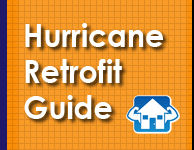|
|
|
PDF Version
Questions
|
|
Home > Roofs > Shingle Roofs
|
|
Shingle Roofs
What to do you if you re-roof,
What you can do if you don't re-roof,
Roofing Terms,
Shingle Roof Checklist and Retrofit Suggestions,
After a Hurricane
|
|
|
This section provides guidance for use in evaluating your shingle roof and it includes suggestions for what you can do based on what you find. As you read through the information on roofs, some of the terms used may not be familiar to you. You can click on Roofing Terms to access a list of definitions that may be helpful.
Information About Shingles
Wind ratings of shingles:
The wind ratings of shingles have increased dramatically over the past 10 years. In the mid to late 1990ís you would have been hard pressed to find shingles rated for more than 65 mph winds. The first ratings in excess of 100 mph were those developed using an American Society of Testing and Materials (ASTM) test standard ASTM D 3161 where 110 mph winds were blown over inclined surfaces of shingles for a one hour period. Shingles that passed this test were designated as F rated shingles per ASTM D 3161 modified to 110 mph. Within the last few years, a new test standard (ASTM D 7158) has been adopted that uses a two step process to develop a wind rating for shingles. The first step involves blowing wind over the surface of the shingles to determine the uplift force on the edge. Then the uplift resistance of adhered or interlocked shingles is measured and that resistance is used to back calculate the wind speed required to create an uplift force large enough to lift up the bottom edge of the shingle, breaking its bond or connection to the shingle below. The following table lists the shingle designations and their corresponding wind ratings.
Asphalt Shingle wind-resistance classifications based on ASTM D 7158
| Classification |
3-Second Gust Design Wind Speed |
| A | 60 mph |
| D | 90 mph |
| F | 110 mph |
| G | 120 mph |
| H | 150 mph |
If you have had your shingles replaced within the past few years, you may be able to determine the wind rating of the shingles from information on the proposal or invoice from your roofer or from the wrapper if the roofer left some spare shingles.
Age:
Sooner or later, all roofing needs to be replaced. If shingles are old and worn, patching or limited repairs won't help when a hurricane strikes. If you know how long it has been since your shingles were replaced, that is a good starting point. While many of the better products come with limited warranties for 25, 30 years or more, the hot sunny Florida climate conspires to shorten that life span. Ultraviolet rays break down the asphalt used to bind the stone granules to the top surface and heat bakes the shingles causing the components to break down and the shingles to become brittle and lose strength. The standard 3-tab shingles used in the past were typically rated for only 15 years. In addition, most if not all of the older warranties were voided for hurricanes.

|
Failure Rate during 120 MPH Winds by Age of Roof
(click image for larger version) |
|
Studies of hurricane damage have shown that when wind gusts exceed about 120 mph, between 3 and 5 out of 10 shingle roofs suffered enough damage to require re-roofing, regardless of the age of the roof. As shingle roofs get to be more than about 10 years old, the failure rates in areas that likely experienced only 75 to 95 mph gusts ran at a rate of 1 to 2 out of 10, while the failure rates dropped to about 1 in 20 or less for roofs that were less than 5 years old.

|
Failure Rate during 95 MPH Winds by Age of Roof
(click image for larger version) |
|
Consequently, if your roof is more than 10 years old and particularly if it shows some of the signs of aging outlined below, you are likely to suffer significant shingle damage if a strong hurricane strikes your community.
Hope for the Future?
When it comes to installing a new shingle roof, there are several signs that suggest that future performance can be better than past experience. First, there are new products available on the market with significantly higher wind ratings than in the past. Second, it has been clearly demonstrated that lighter colored shingles do not get as hot as darker shingles so they should hold their strength longer. Unfortunately, the higher rated products are so new that we don't have experience to show how well they will hold up over the long haul and there has not been any systematic study of the influence of shingle color and age on hurricane performance.
Caution About Warranties / Warranty Limitations
Warranties are largely developed for marketing purposes and roof cover warranties are frequently of limited value. Most of the manufacturer's warranties are limited to errors and defects in the product and shift the responsibility for the warranty on the installed product, if there is one, to the installer.
Evaluating Your Shingle
If you want to try to evaluate your shingles, you will need to climb up to the roof. If you are not able to make the inspection yourself, get a reputable roofer or home inspector to evaluate your roof. (Check with neighbors and friends for referrals and check with the Better Business Bureau).
Before you go up on your roof to evaluate your shingles, please read about Ladder Safety Tips. Then read the text below so that you will have a good idea of what to look for when you get on the roof. Print out the Shingle Roof Checklist and Retrofit Suggestions and have that with you on the roof and in the attic. It will help assure that you remember to check everything on the checklist.
Not only should you check shingles while up on the roof, you should also check for other potential weaknesses such as loose roof vents.

If you are not comfortable climbing a ladder to your roof, or your spouse or friends have told you that you have no business on a ladder, you can try binoculars to look over your roof. There are reasons why roofers have extremely high workers compensation rates, so stay off the roof unless you are really comfortable with getting on your roof. If you do climb up read the Ladder Safety Tips. If you are not able to make the inspection yourself, get a reputable roofer or home inspector to evaluate your roof.
|
From your roof
Look for cracks, broken tabs, buckling curling or blistering of the tabs, and tabs with most of the surface granules worn off. These signs of aging are very strong indicators that you are likely to lose shingles during a hurricane. If your shingles are in good shape, they should lie flat and the lower edges should be well adhered to the top surface of the shingle below. Shingles should be inspected at least yearly for signs of aging and weakness. If your shingles are cracked, have broken tabs, you can see shiny white fiberglass fabric (weave), the tabs are bowed or cupped, or granules are worn off, then your shingles are in need of replacement because they will probably not stay on the roof in high winds.
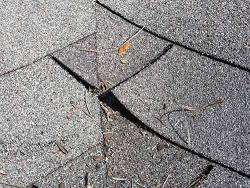
|
Curled Shingle Tab
(click image for larger version) |
|
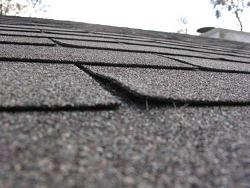
|
Partially Lifted Shingle Tab
(click image for larger version) |
|
|
|
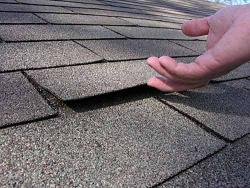
|
Loose Shingle Tab
(click image for larger version) |
|
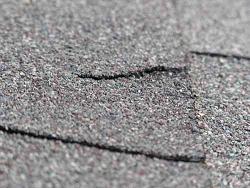
|
Cracked Shingle Tab
(click image for larger version) |
|
|
|
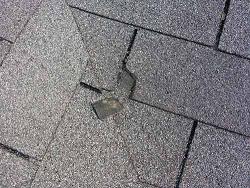
|
Broken Shingle Tab
(click image for larger version) |
|
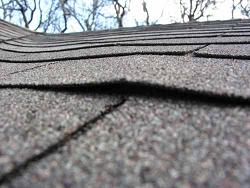
|
Buckled Shingle Tab
(click image for larger version) |
|
|
|
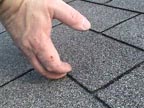
|
Video: Lifting tabs
(click image to view video) |
|
Carefully lift up on a number of tabs:
Using your thumbs or fingers, pressed against the bottom edge of the shingle tab and slowly but firmly lift up on the edge of the shingle to test how well it is attached to the top of the shingle below. Alternatively you can use a small 1Ē wide paint scraper or putty knife to gently pry up on the edge of the shingle tabs. Note that the target bond strength for wind resistant shingle tabs is between 12 and 17 pounds, so don't overdo it. Wind resistance of shingles is all about keeping the tabs adhered to the tops of the shingles below. If several seals are already broken and the tabs are not adhered to the shingle below or if they lift easily, it is probably time to plan on re-roofing. If any of the shingle tabs do separate from the tops of the shingles below, be careful not to lift the edge of that shingle too far, old shingles tend to get brittle and the tabs may break off. If a tab does break off, you can buy some time (for aesthetic purposes) by gluing it back in place using roofing cement. If your shingles are still somewhat flexible and in reasonable shape, you may be able to buy some time before re-roofing by re-sealing the edges of the loose tabs to the tops of the shingles below.
From inside your attic:
On a sunny day, go up into your attic and look for signs of leaks or cracks and holes where you can see light. Use a flashlight to inspect for stains caused by leaks. Look at the roof sheathing, rafters or trusses, and drywall. Look especially carefully around chimneys (including triangular diverters mounted above the chimney to divert water away from the chimney - crickets), and wherever the roof changes shape or slope. Also look for evidence of water on the walls and in the insulation around gable end vents. These signs that water probably entered during a thunderstorm is a good hint that water will enter during a hurricane. Sometimes you can see water stains on rafters or trusses. Inspect around all roof penetrations for things like attic vents, exhausts, skylights, light tunnels, and plumbing stacks. Look for water stains and for cracks or holes where you can see light shining through. Attic vents (the ones that exhaust hot air) may well have water strains around them because they are not terribly effective at keeping windblown rain out. If you see water stains around them, look carefully for around them and try to decide if water was coming in through the vent or around the vent. Check for rusting nails protruding through the roof sheathing as a sign that the leak was around the vent. Another place to check carefully from within the attic (if possible) is below locations where electric wires from a power pole penetrate the roof. This is a common source of leaks.
Inside your house:
look for cracked or peeling paint, discolored gypsum board, and peeling wallpaper as signs of damaged roof areas. However, be aware that another cause of stains on a ceiling can come from air conditioning ducts that sweat, i.e. drops of water from condensation that forms on the ducts in a hot humid attic.
Evaluating Other Weaknesses (The anchorage of ridge vents, off-ridge vents, skylights, light tubes, and turbines)
From the top of the roof:
Check off-ridge vents to see if they are loose, check for fasteners anchoring turbines to the round duct that sticks up through the roof. Check to make sure that the round duct is secure. Check around all pipes that stick up through the roof. The flashing around the pipe should be sealed to the pipe with no gaps or cracks. Inspect to determine whether squirrels have gnawed on seals around vent pipes. They tend to chew on the lead boots that wrap those pipes and provide the weather seal to the roof. Sometimes squirrels chew so much of the metal away that leaks are created at the tops of the pipes between the lead and the pipe. Look at the condition of boots around pipes that are made of other materials such as rubber or plastics.
From inside your attic:
Determine the spacing and size (length - do they go all the way through the roof deck?) of nails or screws used to hold down ridge vents, off-ridge attic vents, turbines, and any kitchen or bathroom vents that protrude through the roof. Many times roofers use the same length nails to hold down these things as they do to hold down the shingles. Most likely a longer nail was actually required for adequate anchorage of these items. If longer nails were used and they stick far enough through the roof deck, you can improve the anchorage by clinching (bending over) the nails from inside your attic.
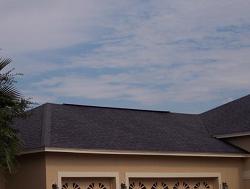
|
Ridge Vent on Shingle Roof
(click image for larger version) |
|

|
Ridge Vent Connection to Roof with
Nails Working Their Way Out a Very common occurrence
(click image for larger version) |
|
|
|
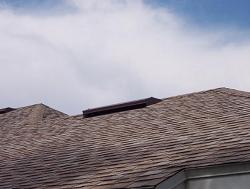
|
Off-Ridge Vent on Shingle Roof
(click image for larger version) |
|

|
Roof Ventilation Turbine
(click image for larger version) |
|
|
|
Get an Expert Opinion:
If you are not able to make the inspection yourself or your inspection shows some problems and you want a second opinion, get a reputable roofer or home inspector to evaluate your roof. (Check with neighbors and friends for referrals and check with the Better Business Bureau).
Retrofit Options
If the inspection and evaluation indicate that the roof needs to be replaced, click on What to do if you re-roof to read about what your roofer should do to help ensure that you have a hurricane resistant roof. Guidance is provided on that page for specifications you may want to give to the roofers as you get bids for the re-roofing project. The What to do if you re-roof page also contains a link to a discussion of various roof coverings that may be beneficial if you want to consider different roof cover options. If you are not ready to re-roof, there are still a number of things you can do that will make your roof more hurricane resistant and less prone to water intrusion. Click on What you can do if you donít re-roof to explore these options. If a hurricane strikes and you do have roof damage, click on After a Hurricane to get ideas for how to keep damage from escalating.
Shingle Roof Checklist and Retrofit Suggestions
What to do you if you re-roof
What you can do if you don't re-roof
After a Hurricane
Roofing Terms
|
|
PDF Version
|
|
|
